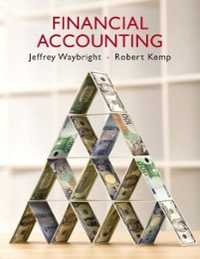Question
DATE: 10/15/14 BREATHESCREEN INC. TRANSACTION ANALYSIS AND FINANCIAL STATEMENTS Dr. John Anderson previously worked as a research scientist for Sensor Inc., a company that develops
DATE: 10/15/14 BREATHESCREEN INC.
TRANSACTION ANALYSIS AND FINANCIAL STATEMENTS
Dr. John Anderson previously worked as a research scientist for Sensor Inc., a company that
develops tiny sensors that detect and identify trace amounts of chemicals in the air. Sensor Inc.
markets and sells the sensors to industrial companies to assist with leak and hazardous agent
detection. Anderson plans to license the technology and develop the sensor for a device that
would help physicians detect early-stage cancers. Patients would breathe directly into the
device, which would analyze a user's breath for traces of key compounds associated with the
most common cancers. In addition to eliminating the need for invasive biopsy procedures, the
screening tool would also be inexpensive, easy to use and provide immediate results.
In 2012, Anderson applied for the trademark for "BreatheScreen" with the United States Patent
and Trademark Office and was granted the trademark in November 2012. In addition to the
small entity electronic filing fee of $375 for the trademark, Anderson paid $2,500 to a lawyer
who assisted him with the filing process.
The following provides a summary of events for 2013:
1. On January 2, Anderson, together with three investors, established BreatheScreen Inc.
BreatheScreen issued 17,000,000 common shares to investors for $2 per share.
2. Also on January 2, BreatheScreen issued an additional 3,000,000 shares, which were
given to Anderson in exchange for the trademark "BreatheScreen." The trademark is
viewed as a key success factor to the business.
3. On January 5, BreatheScreen signed a one-year licensing agreement with Sensor Inc. The
licensing period began on February 1, 2013, and the annual fee of $3,000,000 was paid in
full.
Jaclyn Foroughi, CFA, and Professors Madhav Rajan and Anne Beyer prepared this case as the basis for class
discussion rather than to illustrate either effective or ineffective handling of an administrative situation. This case
study is for illustrative purposes only and is based on the fictional details provided by the authors.
Copyright 2014 by the Board of Trustees of the Leland Stanford Junior University. Publicly available cases are
distributed through Harvard Business Publishing at hbsp.harvard.edu and The Case Centre at thecasecentre.org;
please contact them to order copies and request permission to reproduce materials. No part of this publication may
be reproduced, stored in a retrieval system, used in a spreadsheet, or transmitted in any form or by any means --
electronic, mechanical, photocopying, recording, or otherwise -- without the permission of the Stanford Graduate
School of Business. Every effort has been made to respect copyright and to contact copyright holders as
appropriate. If you are a copyright holder and have concerns, please contact the Case Writing Office at
c..o@gsb.stanford.edu or write to Case Writing Office, Stanford Graduate School of Business, Knight Management
Center, 655 Knight Way, Stanford University, Stanford, CA 94305-5015.
This document is authorized for use only in Financial Statement Analysis - 25 July 2016 by Dr Ding Ding, SIM University from July 2016 to September 2016. BreatheScreen Inc.: Transaction Analysis and Financial Statements A-216 p. 2 4. On January 10, BreatheScreen purchased new machinery that will be used in the
production of the BreatheScreen for $13,500,000 in cash. An additional $1,500,000 was
paid for installation.
5. BreatheScreen contracted with a small health technology company to modify the original
sensing chip to detect certain volatile organic compounds (VOCs) associated with cancer.
Toward the end of February 2013, the health technology company delivered the required
specifications and a pre-production model and was paid a total of $2,000,000.
6. On February 23, BreatheScreen paid $6,000,000 upon receiving a delivery of materials
for use in the production of BreatheScreen.
7. BreatheScreen paid $400,000 for salaries to corporate officers and employees (for the
Step by Step Solution
There are 3 Steps involved in it
Step: 1

Get Instant Access to Expert-Tailored Solutions
See step-by-step solutions with expert insights and AI powered tools for academic success
Step: 2

Step: 3

Ace Your Homework with AI
Get the answers you need in no time with our AI-driven, step-by-step assistance
Get Started


